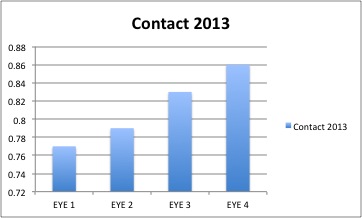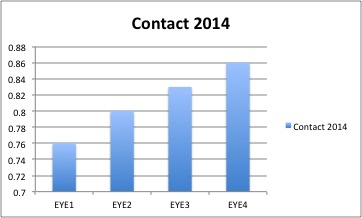A frequent topic on the Fantistics Insider Baseball Show on Sirius XM Fantasy this spring--besides my love for Mookie Betts--has been the type of contact a batter makes. Knowing if linedrives, groundballs, and flyballs are being hit and at what speed helps us make sense of their BABIP profile, yielding more nuanced projections in the process.
However, underneath it all, a batter has to first make contact. Obviously, all else being equal, the more contact a batter is making, the better the chances good things will happen. You know--the runs, the RBI, and AVG contributions tend to increase. Heck, even the SB numbers can see a boost as well. Last year the league average contact rate dipped slightly below 80%. And underneath that, as we continue to peel the onion (to borrow a phrase from Mr. Lou Blasi), in order to improve contact rates, a batter has to develop solid pitch recognition skills. If a pitcher knows he is facing a hitter lacking in an aspect of those skills, then a savvy one will refuse to give the batter a reasonable pitch to hit. Once a hitter shows he is able to recognize such things, then, it's game on!
On today's show we are going to be looking at the psychological aspects of the game (which some are calling "neuroscouting"). Many teams are beginning to invest in gathering metrics on a batter's ability to pick up spin, to time pitches, to hit for a situation, and of course, to distinguish balls from strikes. It's an exciting development in MLB and one I see over the next few years moving into the fantasy realm, especially into the DFS landscape.
For those focused on yearly drafts, perhaps no better statistic exists as a proxy for such a skillset than EYE, which is the ratio of walks to strikeouts. If a batter strikes out 100 times and walks 37 times, this gives us an EYE of .37, which, insanely enough, was the average across MLB in 2014 (at the turn of the century, it was .58). Much like any another other statistic, EYE isn't a catch-all stat. Younger players often struggle to find a balance between aggressiveness and passivity and when to pick their spots. The elder statesmen, meanwhile, are usually compelled to adapt, and as most mere mortals lose bat speed and plate coverage, they tend to rely more on their EYE and acumen to remain effective.
To get a picture on the importance of EYE as a layer of the onion of contact rate, I've looked at qualifying hitters from 2013 and 2014, placing them into groups based upon their EYE and comparing their average contact rates. These groups are based upon how far away, in standard deviations, they are from the average EYE (EYE 1 are those hitters with an EYE more than one standard deviation below the average, EYE 2 are those with an EYE less than AVG but within one standard deviation of that mark, EYE 3 are those with an EYE greater than but within one standard deviation of the average, and EYE 4 are those with an EYE exceeding one standard deviation above the average). For each year, the standard deviation sits at .24.


While there are those that buck the trends, the differences in means across the groups are both statistically and substantively significant.
Of course, these are just snapshots at a given point in time and looking at the aggregate. On today's show, we are going to open a discussion of some players who seem to be improving their EYE (at least from 2013-2014), and we want to know: what does it mean for 2015???
Starlin Castro (SS-CHC): Castro upped his EYE from .23 to .35, a number resembling the mark he posted during his magical 2011-2012 seasons. We didn't see a spike in his contact rate, but if he can continue to exercise some restraint and discernment in the batters box, I see him eclipsing the 83% mark he posted in 2012 (it was 81% last season). With that should come more hits, runs, RBI, and SB opportunities. Isn't it crazy to think that this is only his age-25 season!?!
Brian Dozier (2B-MIN): Somehow a 2B that posted a 20/20 season in 2014 is being underrated heading into 2015. Brian Dozier displayed a marked improvement in his EYE (from .43 to .69) and the simultaneous stagnation in his contact rate suggests that plenty more development remains. His .87 GB/FB rate is troublesome, but as he continues to develop his pitch recognition skills and grow more adept with the stick, I suspect this will move towards the 1.00 range, a number more suitable to a speedster batting out of the leadoff position. The software loves him this season, and for good reason.
Starling Marte (OF-PIT): In 2013, during my first spring training writing for Fantistics, I expressed concern over Marte's pitch recognition skills. As a result, I tended to stay away from him in drafts. However, he improved his EYE by 2% in 2013, and last season, he took a significant step forward by posting a .25 mark, some 7% better. When you have a batter that is going to post high BABIP's because of his profile and types of batted balls he hits who is also improving his pitch recognition skills (and with that, likely his contact rate), it all screams BUY ME.
Trevor Plouffe (3B-MIN): He increased his EYE from .30 to .49 and quietly had himself a solid 2014 campaign. Interestingly, his contact rate was rather stagnant, which to me suggests he is putting things together and has more room for improvement left in the tank. We have him projected for 18 home runs while maintaining an AVG in the .270 range, so don't forget him later in drafts.
Denard Span (OF-WAS): He increased his EYE from .55 to .77. With that we saw a slight increase in his contact rate and a nice accumulation of counting stats across the board. Those 94 runs and 31 stolen bases, not to mention that .302 AVG, looks to be legit heading into 2015, so if you miss out on Billy Hamilton and Ben Revere, Span isn't a terrible consolation prize--as long as he is healthy and that troublesome groin is healed for opening day.
While I wanted this to be a column rooted in optimism, I'd be remiss if I didn't mention one important player whose worrisome trends in EYE and contact rate portend regression in 2015. With that, I give you Chris Carter.
Chris Carter (DH-HOU): Carter's EYE dropped from .33 to .31 and with that we saw a slight drop in his already abysmal contact rate (which now sits at just under 65%!). You are paying for the home runs, granted, but his speed off bat and HR distance numbers suggest his 22% HR/FB rate was inflated. When pitchers start refusing to give in as frequently, and when those just enough homers turn to doubles or warning track outs, Carter's production is going to fall significantly. With an ADP of 114, we advise restraint.
Follow us on Twitter @fantistics & @walterkuberski
Not yet a member? Take the Fantistics Draft Software for a spin with a free demo!





































Michael
Mar 1, 15 at 12:09 AM
I think Dozier will bat 2nd with DSantana leading off this year. I belive the Twins batters will improve simply because they have Paul Molitor as their new manager.
Walter
Mar 1, 15 at 12:09 AM
I can definitely see both scenarios playing out. HOF hitters like Molitor can truly have a huge impact on a team. If you add improvements at the top of the lineup with the underrated thunder of Arcia, Vargas, and Plouffe, the Twins could easily hang around .500. Thanks for reading!